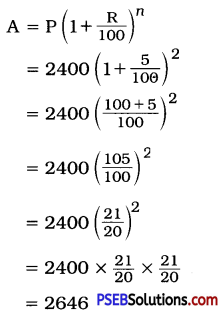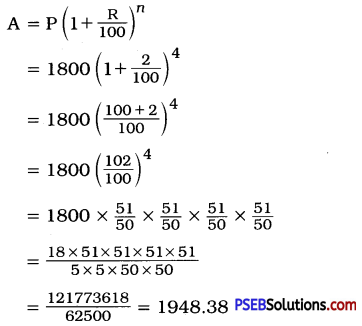Punjab State Board PSEB 8th Class Punjabi Book Solutions Chapter 5 ਵਿਸਾਖੀ ਦਾ ਮੇਲਾ Textbook Exercise Questions and Answers.
PSEB Solutions for Class 8 Punjabi Chapter 5 ਵਿਸਾਖੀ ਦਾ ਮੇਲਾ
(i) ਛੋਟੇ ਉੱਤਰ ਵਾਲੇ ਪ੍ਰਸ਼ਨ
ਪ੍ਰਸ਼ਨ 1.
ਵਿਸਾਖੀ ਦੇ ਮੇਲੇ ‘ਤੇ ਕਿੰਨੀ ਕੁ ਭੀੜ ਹੁੰਦੀ ਹੈ ?
ਉੱਤਰ :
ਇੰਨੀ ਕਿ ਪੈਰ ਧਰਨ ਨੂੰ ਥਾਂ ਨਹੀਂ ਹੁੰਦੀ ।
ਪ੍ਰਸ਼ਨ 2.
ਇਸ ਕਵਿਤਾ ਵਿੱਚ ਕਿਨ੍ਹਾਂ ਮਠਿਆਈਆਂ ਦਾ ਜ਼ਿਕਰ ਆਇਆ ਹੈ ?
ਉੱਤਰ :
ਲੱਡੂਆਂ ਤੇ ਜਲੇਬੀਆਂ ਦਾ ।
ਪ੍ਰਸ਼ਨ 3.
ਮੇਲੇ ਵਿੱਚ ਲੋਕਾਂ ਨੇ ਕੱਪੜੇ ਕਿਸ ਤਰ੍ਹਾਂ ਦੇ ਪਾਏ ਹੁੰਦੇ ਹਨ ?
ਉੱਤਰ :
ਰੰਗ-ਬਰੰਗੇ ਕੁੜਤੇ ਤੇ ਚਾਦਰੇ ।
ਪ੍ਰਸ਼ਨ 4.
ਮੇਲਿਆਂ ਦੀ ਸੈਰ ਕਿਹੜੇ ਲੋਕ ਕਰ ਸਕਦੇ ਹਨ ?
ਉੱਤਰ :
ਜਿਹੜੇ ਧੂੜ, ਧੁੱਪ ਤੇ ਧੱਕੇ ਸਹਿ ਸਕਦੇ ਹਨ ।
![]()
ਪ੍ਰਸ਼ਨ 5.
ਪੰਜਾਬ ਦੇ ਰੰਗਲੇ ਮੇਲੇ ਕਿਸ ਫੁੱਲ ਵਾਂਗ ਲਗਦੇ ਹਨ ?
ਉੱਤਰ :
ਗੁਲਾਬ ਦੇ ਫੁੱਲ ਵਰਗੇ ।
(ii) ਕੁੱਝ ਹੋਰ ਪ੍ਰਸ਼ਨ
ਪ੍ਰਸ਼ਨ 1.
ਹਾਂ ਜਾਂ ਨਾਂਹ ਵਿਚ ਉੱਤਰ ਦਿਓ :
(ਉ) ਵਿਸਾਖੀ ਦੇ ਮੇਲੇ ‘ਤੇ ਬਹੁਤੀ ਭੀੜ ਨਹੀਂ ਹੁੰਦੀ ।
(ਅ) ਹਟਵਾਣੀਏ ਮੇਲੇ ਵਿਚ ਬਹੁਤ ਖੱਟੀ ਕਰਦੇ ਹਨ ।
(ਈ) ਵਿਸਾਖੀ ਉੱਤੇ ਲੋਕ ਆਮ ਕੱਪੜੇ ਪਾਉਂਦੇ ਹਨ ।
(ਸ) ਕਵੀਸ਼ਰ ਵੀ ਵਿਸਾਖੀ ਦੇ ਮੌਕੇ ਆਪਣੇ ਬੋਲ ਸੁਣਾਉਂਦੇ ਹਨ ।
(ਹ) ਮੱਲ ਵਿਸਾਖੀ ਦੇ ਮੌਕੇ ‘ਤੇ ਆਪਣੀ ਕਲਾ ਦਾ ਪ੍ਰਦਰਸ਼ਨ ਨਹੀਂ ਕਰਦੇ ।
ਉੱਤਰ :
(ਉ) ਨਹੀਂ, (ਅ) ਹਾਂ, (ਈ) ਨਹੀਂ, (ਸ) ਹਾਂ, (ਹ) ਨਹੀਂ ।
ਪ੍ਰਸ਼ਨ 2.
ਵਾਕਾਂ ਵਿੱਚ ਵਰਤੋ :
ਪੈਰ ਧਰਨਾ, ਸ਼ੁਕੀਨ, ਕਵੀਸ਼ਰ, ਮੁਲਖੱਈਆ, ਸਵਾਰੀਆਂ ।
ਉੱਤਰ :
1. ਪੈਰ ਧਰਨਾ (ਦਾਖ਼ਲ ਹੋਣਾ) – ਮੇਲੇ ਵਿਚ ਭੀੜ ਕਾਰਨ ਪੈਰ ਧਰਨ ਦੀ ਥਾਂ ਨਹੀਂ ਸੀ ।
2. ਸ਼ੁਕੀਨ (ਸ਼ੌਕ ਰੱਖਣ ਵਾਲਾ) – ਮਠਿਆਈਆਂ ਦੇ ਸ਼ੁਕੀਨ ਹਲਵਾਈਆਂ ਦੀਆਂ ਦੁਕਾਨਾਂ ਦੁਆਲੇ ਖੜ੍ਹੇ ਸਨ ।
3. ਕਵੀਸ਼ਰ (ਸਟੇਜੀ ਕਵੀ) – ਮੇਲੇ ਵਿਚ ਕਵੀਸ਼ਰਾਂ ਨੇ ਆਪਣੀਆਂ ਹਸਾਉਣੀਆਂ ਕਵਿਤਾਵਾਂ ਨਾਲ ਖੂਬ ਰੰਗ ਬੰਨ੍ਹਿਆ ਹੋਇਆ ਸੀ ।
4. ਮੁਲਖੱਈਆ (ਲੋਕ, ਦੁਨੀਆ) – ਮੇਲੇ ਵਿਚ ਐਨਾ ਮੁਲਖੱਈਆ ਇਕੱਠਾ ਹੋਇਆ ਸੀ ਕਿ ਤਿਲ ਸੁੱਟਣ ਦੀ ਥਾਂ ਨਹੀਂ ਸੀ ।
5. ਸਵਾਰੀਆਂ (ਗੱਡੀ ਦੇ ਮੁਸਾਫ਼ਿਰ) – ਬੱਸਾਂ ਸਵਾਰੀਆਂ ਨਾਲ ਭਰੀਆਂ ਪਈਆਂ ਸਨ ।
ਪ੍ਰਸ਼ਨ 3.
ਹੇਠ ਲਿਖੇ ਸ਼ਬਦਾਂ ਨਾਲ ਤੁਕਾਂਤ ਮਿਲਾਓ :
ਹੱਟੀਆਂ – …………..
ਮੇਲੀਆਂ – …………..
ਚੁੱਕਿਆ – …………..
ਲਾਰੀਆਂ – …………..
ਗੁਲਾਬ – …………..
ਉੱਤਰ :
ਹੱਟੀਆਂ – ਖੱਟੀਆਂ
ਮੇਲੀਆਂ – ਬੇਲੀਆਂ
ਚੁੱਕਿਆ – ਉੱਕਿਆ
ਲਾਰੀਆਂ – ਸਵਾਰੀਆਂ
ਗੁਲਾਬ – ਪੰਜਾਬ
![]()
ਪ੍ਰਸ਼ਨ 4.
ਖ਼ਾਲੀ ਸਥਾਨ ਭਰੋ :
ਕਿੰਨਾ ਹੈ ਵਿਸਾਖੀ ਵਾਲਾ ………….
…………….. ਖੜ੍ਹੇ ਬੰਨ੍ਹ ਪਾਲ ਨੇ ।
ਕੱਪੜੇ ਨੇ ਪਾਏ ਲੋਕਾਂ ……………
………………… ਗੱਲਾਂ ਨੇ ਸੁਣਾਉਂਦੇ
…. ਵਿੱਚ ਬੱਸਾਂ, ਲਾਰੀਆਂ ।
ਉੱਤਰ :
ਕਿੰਨਾ ਹੈ ਵਿਸਾਖੀ ਵਾਲਾ, ਮੇਲਾ ਭਰਿਆ ।
ਖਾਣ ਦੇ ਸ਼ੁਕੀਨ, ਖੜ੍ਹੇ ਬੰਨ੍ਹ ਪਾਲ ਨੇ ।
ਕੱਪੜੇ ਨੇ ਪਾਏ ਲੋਕਾਂ, ਰੰਗਾ ਰੰਗ ਦੇ ।
ਗੱਲਾਂ ਨੇ ਸੁਣਾਉਂਦੇ, ਸਾਡੀਆਂ-ਤੁਹਾਡੀਆਂ ।
ਭੀੜ ਹੋਵੇ ਐਨੀ, ਵਿੱਚ ਬੱਸਾਂ ਲਾਰੀਆਂ ।
ਪ੍ਰਸ਼ਨ 5.
ਹੇਠ ਲਿਖੀਆਂ ਸਤਰਾਂ ਨੂੰ ਸੁੰਦਰ ਲਿਖਾਈ ਕਰ ਕੇ ਲਿਖੋ :
ਧੂੜ, ਧੁੱਪ, ਧੱਕੇ ਜਿਹੜੇ ਜਰ ਸਕਦੇ ।
ਮੇਲਿਆਂ ਦੀ ਸੈਰ ਸੋਈ ਕਰ ਸਕਦੇ ।
ਉੱਤਰ :
……………………………………..
……………………………………..
ਪ੍ਰਸ਼ਨ 6.
ਤੁਸੀਂ ਕਦੇ ਕੋਈ ਮੇਲਾ ਜ਼ਰੂਰ ਵੇਖਿਆ ਹੋਵੇਗਾ, ਉਸ ਦਾ ਜ਼ਿਕਰ ਆਪਣੇ ਸ਼ਬਦਾਂ ਵਿੱਚ ਕਰੋ ।
ਉੱਤਰ :
ਨੋਟ-ਉੱਤਰ ਲਈ ਦੇਖੋ ਲੇਖ-ਰਚਨਾ ਵਾਲੇ ਭਾਗ ਵਿਚ “ਅੱਖੀਂ ਡਿੱਠਾ ਮੇਲਾ’ ਜਾਂ ‘ਦੁਸਹਿਰਾ’ ।
![]()
ਪਸ਼ਨ 7.
ਵਿਸਾਖੀ ਦਾ ਮੇਲਾ’ ਕਵਿਤਾ ਦੀਆਂ ਪੰਜ-ਛੇ ਸਤਰਾਂ ਜ਼ਬਾਨੀ ਲਿਖੋ ।
ਉੱਤਰ :
ਕਿੰਨਾ ਹੈ ਵਿਸਾਖੀ ਵਾਲਾ ਮੇਲਾ ਭਰਿਆ ।
ਜਾਏ ਨਾ ਬਜ਼ਾਰਾਂ ਵਿਚ ਪੈਰ ਧਰਿਆ ॥
ਕਿੰਝ ਹਟਵਾਣੀਆਂ ਨੇ ਪਾਈਆਂ ਹੱਟੀਆਂ ।
ਦੋਹੀਂ ਹੱਥੀਂ ਕਰਦੇ ਸਵਾਈਆਂ ਖੱਟੀਆਂ ।
ਲੱਡੂਆਂ ਜਲੇਬੀਆਂ ਦੇ ਭਰੇ ਥਾਲ ਨੇ ।
ਖਾਣ ਦੇ ਸ਼ੌਕੀਨ ਖੜੇ ਬੰਨ ਪਾਲ ਨੇ ।
(ਉ) ਕਿੰਨਾ ਹੈ ਵਿਸਾਖੀ ਵਾਲਾ ਮੇਲਾ ਭਰਿਆ ।
ਜਾਏ ਨਾ ਬਜ਼ਾਰਾਂ ਵਿਚ ਪੈਰ ਧਰਿਆ ।
ਕਿੰਝ ਹਟਵਾਣੀਆਂ ਨੇ ਪਾਈਆਂ ਹੱਟੀਆਂ ।
ਦੋਹੀਂ ਹੱਥੀਂ ਕਰਦੇ ਸਵਾਈਆਂ ਖੱਟੀਆਂ
ਲੱਡੂਆਂ ਜਲੇਬੀਆਂ ਦੇ ਭਰੇ ਥਾਲ ਨੇ ।
ਖਾਣ ਦੇ ਸ਼ੌਕੀਨ ਖੜ੍ਹੇ ਬੰਨ੍ਹ ਪਾਲ ਨੇ ।
ਪ੍ਰਸ਼ਨ 1.
(i) ਉਪਰੋਕਤ ਕਾਵਿ-ਟੋਟੇ ਦੇ ਭਾਵ-ਅਰਥ ਲਿਖੋ ।
(ii) ਇਸ ਕਾਵਿ-ਟੋਟੇ ਵਿਚ ਕਿਹੜੇ ਮੇਲੇ ਦਾ ਜ਼ਿਕਰ ਹੈ ?
(iii) ਮੇਲੇ ਵਿਚ ਕਿੰਨੀ ਕੁ ਭੀੜ ਹੈ ?
(iv) ਹੱਟੀਆਂ ਕਿਨ੍ਹਾਂ ਨੇ ਪਾਈਆਂ ਹਨ ?
(v) ਹੱਟੀਆਂ ਵਾਲੇ ਕਿੰਨੀ ਕੁ ਕਮਾਈ ਕਰ ਰਹੇ ਹਨ ?
(vi) ਥਾਲ ਕਿਨ੍ਹਾਂ ਚੀਜ਼ਾਂ ਨਾਲ ਭਰੇ ਹੋਏ ਹਨ ?
(vii) ਇਨ੍ਹਾਂ ਸਤਰਾਂ ਵਿਚ ਕਿਹੜੀ-ਕਿਹੜੀ ਮਠਿਆਈ ਦਾ ਜ਼ਿਕਰ ਹੈ ?
ਉੱਤਰ :
(i) ਵਿਸਾਖੀ ਦਾ ਮੇਲਾ ਭਰਿਆ ਹੋਣ ਕਰਕੇ ਭੀੜ ਬਹੁਤ ਹੈ । ਹਟਵਾਣੀਆਂ ਨੇ ਬਹੁਤ ਸਾਰੀਆਂ ਹੱਟੀਆਂ ਪਾਈਆਂ ਹੋਈਆਂ ਹਨ ਤੇ ਖੂਬ ਕਮਾਈਆਂ ਕਰ ਰਹੇ ਹਨ । ਮੇਲੇ ਵਿਚ ਦੁਕਾਨਾਂ ਉੱਤੇ ਲੱਡੂ-ਜਲੇਬੀਆਂ ਦੇ ਥਾਲ ਭਰੇ ਹੋਏ ਹਨ ਤੇ ਉਨ੍ਹਾਂ ਨੂੰ ਖਾਣ ਦੇ ਸ਼ੁਕੀਨ ਕਤਾਰਾਂ ਬੰਨ੍ਹ ਕੇ ਲੈਣ ਲਈ ਖੜੇ ਹਨ ।
(ii) ਵਿਸਾਖੀ ਦੇ ਮੇਲੇ ਦਾ ।
(iii) ਬਹੁਤ ਜ਼ਿਆਦਾ ।
(iv) ਹਟਵਾਣੀਆਂ ਨੇ ।
(v) ਬਹੁਤ ਜ਼ਿਆਦਾ ।
(vi) ਲੱਡੂਆਂ ਤੇ ਜਲੇਬੀਆਂ ਨਾਲ !
(vii) ਲੱਡੂ ਤੇ ਜਲੇਬੀਆਂ ।
![]()
(ਅ) ਟੋਲੀਆਂ ਬਣਾਈਆਂ ਵੱਖੋ-ਵੱਖ ਮੇਲੀਆਂ ।
ਸੋਭਦੇ ਨੇ ਮੇਲੇ ਸਦਾ ਨਾਲ ਬੇਲੀਆਂ ।
ਸੀਟੀਆਂ, ਸਪੀਕਰਾਂ ਨੇ ਪਾਇਆ ਸ਼ੋਰ ਹੈ ।
ਸ਼ੋਰ ਨਾਲ ਮੇਲੇ ਵਿਚ ਆਉਂਦਾ ਲੋਰ ਹੈ ।
ਕੱਪੜੇ ਨੇ ਪਾਏ ਲੋਕਾਂ ਰੰਗਾ-ਰੰਗ ਦੇ ।
ਕੁੜਤੇ ਤੇ ਚਾਦਰੇ ਨੇ ਕਈ ਢੰਗ ਦੇ ।
ਪ੍ਰਸ਼ਨ 2.
(i) ਉਪਰੋਕਤ ਕਾਵਿ-ਟੋਟੇ ਦੇ ਭਾਵ-ਅਰਥ ਲਿਖੋ ।
(ii) ਮੇਲਾ ਵੇਖਣ ਵਾਲੇ ਮੇਲਾ ਕਿਸ ਤਰ੍ਹਾਂ ਵੇਖ ਰਹੇ ਹਨ ?
(iii) ਮੇਲੇ ਕਿਨ੍ਹਾਂ ਨਾਲ ਚੰਗੇ ਲਗਦੇ ਹਨ ?
(iv) ਕਿਨ੍ਹਾਂ ਚੀਜ਼ਾਂ ਨੇ ਸ਼ੋਰ ਪਾਇਆ ਹੋਇਆ ਹੈ ?
(v) “ਲੋਰ ਦੇ ਕੀ ਅਰਥ ਹਨ ?
(vi) ਲੋਕਾਂ ਨੇ ਕਿਹੋ-ਜਿਹੇ ਕੱਪੜੇ ਪਾਏ ਹੋਏ ਹਨ ?
ਉੱਤਰ :
(i) ਮੇਲੇ ਵਿਚ ਮੇਲਾ ਦੇਖਣ ਦੇ ਸ਼ੌਕੀਨ ਗੱਭਰੂ ਦੋਸਤ ਟੋਲੀਆਂ ਵਿਚ ਘੁੰਮ ਰਹੇ । ਹਨ। ਮੇਲੇ ਵਿਚ ਵਜ ਰਹੇ ਸਪੀਕਰਾਂ ਤੇ ਸੀਟੀਆਂ ਦਾ ਸ਼ੋਰ ਪਿਆ ਹੋਇਆ ਹੈ । ਮੇਲਾ ਵੇਖ ਰਹੇ ਲੋਕਾਂ ਨੇ ਕਈ ਰੰਗਾਂ ਤੇ ਨਮੂਨਿਆਂ ਦੇ ਕੱਪੜੇ ਪਾਏ ਹੋਏ ਹਨ ।
(ii) ਟੋਲੀਆਂ ਬਣਾ ਕੇ ।
(iii) ਬੇਲੀਆਂ ਨਾਲ ।
(iv) ਸੀਟੀਆਂ ਅਤੇ ਸਪੀਕਰਾਂ ਨੇ ।
(v) ਮਸਤੀ ।
(vi) ਵੱਖ-ਵੱਖ ਰੰਗਾਂ ਅਤੇ ਢੰਗਾਂ ਦੇ ।
(ੲ) ਕੀਤੀ ਹੋਈ ਸ਼ੁਰੂ ਕਿਤੇ ‘ਵਾਰ’ ਢਾਡੀਆਂ ।
ਗੱਲਾਂ ਨੇ ਸੁਣਾਉਂਦੇ ਸਾਡੀਆਂ ਤੁਹਾਡੀਆਂ ।
ਕਿਧਰੇ ਪੰਘੂੜੇ ਤੇ ਚੰਡੋਲ ਕਿਧਰੇ ।
ਸੁਣਦੇ ਕਵੀਸ਼ਰਾਂ ਦੇ ਬੋਲ ਕਿਧਰੇ ।
ਆਥਣੇ ਅਖਾੜੇ ਵਿਚ ਢੋਲ ਵੱਜਦੇ ।
ਸ਼ੇਰਾਂ ਵਾਂਗ ਮੱਲ ਨੇ ਅਖਾੜੀ ਗੱਜਦੇ ।
ਪ੍ਰਸ਼ਨ 3.
(i) ਉਪਰੋਕਤ ਕਾਵਿ-ਟੋਟੇ ਦੇ ਭਾਵ-ਅਰਬ ਲਿਖੋ ।
(ii) ਢਾਡੀ ਕੀ ਗਾ ਰਹੇ ਹਨ ?
(iii) ਢਾਡੀ ਕਿਨ੍ਹਾਂ ਦੀਆਂ ਗੱਲਾਂ ਸੁਣਾ ਰਹੇ ਹਨ ?
(iv) ਪੰਘੂੜੇ ਤੇ ਚੰਡੋਲ ਕਿੱਥੇ ਦਿਖਾਈ ਦੇ ਰਹੇ ਹਨ ?
(v) ਕਿਨ੍ਹਾਂ ਦੇ ਬੋਲ ਸੁਣਾਈ ਦੇ ਰਹੇ ਹਨ ?
(vi) ਆਥਣ ਵੇਲੇ ਮੇਲੇ ਵਿਚ ਕੀ ਹੋਇਆ ਹੈ ?
(vii) ਮੱਲ ਕਿੱਥੇ ਕਿਸ ਤਰ੍ਹਾਂ ਗੱਜ ਰਹੇ ਸਨ ?
ਉੱਤਰ :
(i) ਮੇਲੇ ਵਿਚ ਕਿਸੇ ਪਾਸੇ ਢਾਡੀ ਵਾਰਾਂ ਗਾਉਂਦੇ ਹੋਏ ਆਮ ਲੋਕਾਂ ਨਾਲ ਸੰਬੰਧਿਤ ਗੱਲਾਂ ਸੁਣਾ ਰਹੇ ਹਨ । ਕਿਸੇ ਪਾਸਿਓਂ ਕਵੀਸ਼ਰਾਂ ਦੀ ਅਵਾਜ਼ ਆ ਰਹੀ ਹੈ । ਕਿਧਰੇ ਲੋਕ ਪੰਘੂੜੇ ਤੇ ਚੰਡੋਲ ਝੂਟ ਰਹੇ ਹਨ । ਸ਼ਾਮ ਵੇਲੇ ਅਖਾੜੇ ਵਿਚ ਢੋਲ ਵੱਜਣ ਨਾਲ ਪਹਿਲਵਾਨ ਅਖਾੜਿਆਂ ਵਿਚ ਆ ਨਿੱਤਰੇ ਹਨ ।
(ii) ਵਾਰ ਗਾ ਰਹੇ ਹਨ ।
(iii) ਸਾਡੀਆਂ ਤੇ ਤੁਹਾਡੀਆਂ ।
(iv) ਮੇਲੇ ਵਿਚ ।
(v) ਕਵੀਸ਼ਰਾਂ ਦੇ ।
(vi) ਅਖਾੜੇ ਵਿਚ ਢੋਲ ਵੱਜਣ ਲੱਗੇ ਹਨ ।
(vii) ਮੱਲ ਅਖਾੜਿਆਂ ਵਿਚ ਸ਼ੇਰਾਂ ਵਾਂਗ ਗੱਜ ਰਹੇ ਹਨ ।
![]()
(ਸ) ਐਨਾ ਮੁਲਖੱਈਆ ਮੇਲੇ ਵਿਚ ਚੁੱਕਿਆ ।
ਲੱਭਦਾ ਨਹੀਂ ਬੰਦਾ ਸਾਥ ਨਾਲੋਂ ਉੱਕਿਆ ।
ਭੀੜ ਹੋਵੇ ਐਨੀ ਵਿਚ ਬੱਸਾਂ, ਲਾਰੀਆਂ ।
‘ਤੋਬਾ-ਤੋਬਾ’ ਕਹਿਣ ਚੜ ਕੇ ਸਵਾਰੀਆਂ ।
ਪ੍ਰਸ਼ਨ 4.
(i) ਉਪਰੋਕਤ ਕਾਵਿ-ਟੋਟੇ ਦੇ ਭਾਵ-ਅਰਥ ਲਿਖੋ ।
(ii) ਮੁਲਖੱਈਆ’ ਦਾ ਕੀ ਅਰਥ ਹੈ ?
(iii) ਮੁਲਖੱਈਆ ਕਿੱਥੇ ਇਕੱਠਾ ਹੋਇਆ ਹੈ ?
(iv) ਸਾਥ ਨਾਲੋਂ ਉੱਕਿਆ ਵਿਛੜਿਆ ਬੰਦਾ ਕਿਉਂ ਨਹੀਂ ਲੱਭਦਾ ?
(v) ਸਵਾਰੀਆਂ ‘ਤੋਬਾ-ਤੋਬਾ ਕਿਉਂ ਕਰ ਰਹੀਆਂ ਹਨ ?
ਉੱਤਰ :
(i) ਮੇਲੇ ਵਿਚ ਐਨੀ ਭੀੜ ਹੈ ਕਿ ਇਕ ਵਾਰੀ ਸਾਥ ਨਾਲੋਂ ਖੁੰਝਿਆ ਬੰਦਾ ਮੁੜ ਕੇ ਨਹੀਂ ਲੱਭਦਾ । ਬੱਸਾਂ ਤੇ ਲਾਰੀਆਂ ਨੂੰ ਸਵਾਰੀਆਂ ਨਾਲ ਤੂੜੀਆਂ ਦੇਖ ਕੇ ਲੋਕ ਤੌਬਾ-ਤੋਬਾ ਕਰ ਰਹੇ ਹਨ ।
(ii) ਇਧਰ-ਉੱਧਰ ਤੋਂ ਇਕੱਠੇ ਹੋਏ ਬਹੁਤ ਸਾਰੇ ਲੋਕ ।
(iii) ਮੇਲੇ ਵਿਚ ।
(iv) ਬਹੁਤ ਜ਼ਿਆਦਾ ਭੀੜ ਹੋਣ ਕਰਕੇ ।
(v) ਬੱਸਾਂ ਤੇ ਲਾਰੀਆਂ ਵਿਚ ਬਹੁਤ ਜ਼ਿਆਦਾ ਭੀੜ ਦੇਖ ਕੇ ।
(ਹ) ਧੁੱਪ, ਧੂੜ, ਧੱਕੇ ਜਿਹੜੇ ਜਰ ਸਕਦੇ ।
ਮੇਲਿਆਂ ਦੀ ਸੈਰ ਸੋਈ ਕਰ ਸਕਦੇ ।
ਫੁੱਲਾਂ ਵਿੱਚੋਂ ਫੁੱਲ ਸੋਭਦੇ ਗੁਲਾਬ ਦੇ ।
ਮੇਲਿਆਂ ‘ਚੋਂ ਮੇਲੇ ਰੰਗਲੇ ਪੰਜਾਬ ਦੇ ।
ਪ੍ਰਸ਼ਨ 5.
(i) ਉਪਰੋਕਤ ਕਾਵਿ-ਟੋਟੇ ਦੇ ਭਾਵ-ਅਰਥ ਲਿਖੋ ।
(ii) ਮੇਲਿਆਂ ਦੀ ਸੈਰ ਕੌਣ ਕਰ ਸਕਦਾ ਹੈ ?
(iii) ਫੁੱਲਾਂ ਵਿਚੋਂ ਸਭ ਤੋਂ ਸੋਹਣੇ ਫੁੱਲ ਕਿਹੜੇ ਹੁੰਦੇ ਹਨ ?
(iv) ਕਿੱਥੋਂ ਦੇ ਮੇਲੇ ਸਭ ਤੋਂ ਵੱਧ ਰੰਗਲੇ ਹਨ ?
(v) ਪੰਜਾਬ ਦੇ ਮੇਲੇ ਕਿਹੋ ਜਿਹੇ ਹਨ ?
ਉੱਤਰ :
(i) ਮੇਲੇ ਵਿਚ ਘੁੰਮਣ ਦਾ ਸਵਾਦ ਉਹੋ ਹੀ ਲੈ ਸਕਦੇ ਹਨ, ਜਿਹੜੇ ਧੂੜ, ਧੁੱਪ ਤੇ ਧੱਕੇ ਸਹਿ ਸਕਦੇ ਹਨ । ਉਂਞ ਪੰਜਾਬ ਦੇ ਮੇਲੇ ਸਭ ਤੋਂ ਸੋਹਣੇ ਤੇ ਰੰਗਲੇ ਹੁੰਦੇ ਹਨ ।
(ii) ਜਿਹੜਾ ਮੇਲੇ ਵਿਚ ਧੂੜ, ਧੁੱਪ ਤੇ ਧੱਕਿਆਂ ਨੂੰ ਸਹਿ ਸਕਦਾ ਹੋਵੇ ।
(iii) ਗੁਲਾਬ ਦੇ ।
(iv) ਪੰਜਾਬ ਦੇ ।
(v) ਰੰਗਲੇ ।
![]()
ਕਾਵਿ-ਟੋਟਿਆਂ ਦੇ ਸਰਲ ਅਰਥ
(ੳ) ਕਿੰਨਾ ਹੈ ਵਿਸਾਖੀ ਵਾਲਾ ਮੇਲਾ ਭਰਿਆ ।
ਜਾਏ ਨਾ ਬਜ਼ਾਰਾਂ ਵਿਚ ਪੈਰ ਧਰਿਆ ॥
ਕਿੰਝ ਹਟਵਾਣੀਆਂ ਨੇ ਪਾਈਆਂ ਹੱਟੀਆਂ ।
ਦੋਹੀਂ ਹੱਥੀਂ ਕਰਦੇ ਸਵਾਈਆਂ ਖੱਟੀਆਂ ।
ਲੱਡੂਆਂ ਜਲੇਬੀਆਂ ਦੇ ਭਰੇ ਥਾਲੁ ਨੇ ।
ਖਾਣ ਦੇ ਸ਼ੌਕੀਨ ਖੜੇ ਬੰਨ੍ਹ ਪਾਲ ਨੇ ।
ਔਖੇ ਸ਼ਬਦਾਂ ਦੇ ਅਰਥ : ਧਰਿਆ-ਰੱਖਿਆ । ਹਟਵਾਣੀਆਂ-ਹੱਟੀਆਂ ਵਾਲੇ । ਸਵਾਈਆਂਬਹੁਤ ਜ਼ਿਆਦਾ । ਪਾਲ-ਕਤਾਰ ।
ਪ੍ਰਸ਼ਨ 1.
(i) ਉੱਪਰ ਦਿੱਤੇ ਕਾਵਿ-ਟੋਟੇ ਦੇ ਸਰਲ ਅਰਥ ਲਿਖੋ ।
(ii) ਇਸ ਕਾਵਿ-ਟੋਟੇ ਵਿਚ ਕਿਹੜੇ ਮੇਲੇ ਦਾ ਜ਼ਿਕਰ ਹੈ ?
(iii) ਮੇਲੇ ਵਿਚ ਕਿੰਨੀ ਕੁ ਭੀੜ ਹੈ ?
(iv) ਹੱਟੀਆਂ ਕਿਨ੍ਹਾਂ ਨੇ ਪਾਈਆਂ ਹਨ ?
(v) ਹੱਟੀਆਂ ਵਾਲੇ ਕਿੰਨੀ ਕੁ ਕਮਾਈ ਕਰ ਰਹੇ ਹਨ ?
(vi) ਥਾਲ ਕਿਨ੍ਹਾਂ ਚੀਜ਼ਾਂ ਨਾਲ ਭਰੇ ਹੋਏ ਹਨ ?
(vii) ਇਨ੍ਹਾਂ ਸਤਰਾਂ ਵਿਚ ਕਿਹੜੀ-ਕਿਹੜੀ ਮਠਿਆਈ ਦਾ ਜ਼ਿਕਰ ਹੈ ?
ਉੱਤਰ :
(i) ਵਿਸਾਖੀ ਦਾ ਮੇਲਾ ਕਿਸ ਤਰ੍ਹਾਂ ਦੇਖਣ ਵਾਲੇ ਲੋਕਾਂ ਨਾਲ ਭਰਿਆ ਹੋਇਆ ਹੈ । ਇੰਨੀ ਭੀੜ ਹੈ ਕਿ ਬਜ਼ਾਰਾਂ ਵਿਚ ਪੈਰ ਰੱਖਣ ਦੀ ਥਾਂ ਨਹੀਂ । ਕਿਸ ਤਰ੍ਹਾਂ ਹਰ ਪਾਸੇ ਹਟਵਾਣੀਆਂ ਨੇ ਹੱਟੀਆਂ ਪਾਈਆਂ ਹੋਈਆਂ ਹਨ ! ਉਹ ਦੋਹਾਂ ਹੱਥਾਂ ਨਾਲ ਬਹੁਤ ਜ਼ਿਆਦਾ ਕਮਾਈਆਂ ਕਰ ਰਹੇ ਹਨ । ਹਲਵਾਈਆਂ ਦੀਆਂ ਦੁਕਾਨਾਂ ਉੱਤੇ ਲੱਡੂਆਂ, ਜਲੇਬੀਆਂ ਦੇ ਥਾਲ ਭਰੇ ਹੋਏ ਹਨ, ਜਿਨ੍ਹਾਂ ਨੂੰ ਖਾਣ ਦੇ ਸ਼ੁਕੀਨ ਕਤਾਰਾਂ ਬੰਨ੍ਹ ਕੇ ਹੱਟੀਆਂ ਅੱਗੇ ਖੜ੍ਹੇ ਹਨ ।
(ii) ਵਿਸਾਖੀ ਦੇ ਮੇਲੇ ਦਾ ।
(iii) ਬਹੁਤ ਜ਼ਿਆਦਾ ।
(iv) ਹਟਵਾਣੀਆਂ ਨੇ ।
(v) ਬਹੁਤ ਜ਼ਿਆਦਾ ।
(vi) ਲੱਡੂਆਂ ਤੇ ਜਲੇਬੀਆਂ ਨਾਲ ।
(vi) ਲੱਡੂ ਤੇ ਜਲੇਬੀਆਂ ।
![]()
(ਅ) ਟੋਲੀਆਂ ਬਣਾਈਆਂ ਵੱਖੋ-ਵੱਖ ਮੇਲੀਆਂ ।
ਸੋਭਦੇ ਨੇ ਮੇਲੇ ਸਦਾ ਨਾਲ ਬੇਲੀਆਂ ।
ਸੀਟੀਆਂ, ਸਪੀਕਰਾਂ ਨੇ ਪਾਇਆ ਸ਼ੋਰ ਹੈ ।
ਸ਼ੋਰ ਨਾਲ ਮੇਲੇ ਵਿਚ ਆਉਂਦਾ ਲੋਰ ਹੈ ।
ਕੱਪੜੇ ਨੇ ਪਾਏ ਲੋਕਾਂ ਰੰਗਾ-ਰੰਗ ਦੇ ।
ਕੁੜਤੇ ਤੇ ਚਾਦਰੇ ਨੇ ਕਈ ਢੰਗ ਦੇ ।
ਔਖੇ ਸ਼ਬਦਾਂ ਦੇ ਅਰਥ : ਮੇਲੀਆਂ-ਮੇਲਾ ਵੇਖਣ ਵਾਲਿਆਂ । ਬੇਲੀਆਂ-ਮਿੱਤਰਾਂ, ਯਾਰਾਂ । ਲੋਰ-ਮਸਤੀ । ਰੰਗਾ-ਰੰਗ-ਕਈ ਰੰਗਾਂ ਦੇ । ਚਾਦਰੇ-ਧੋਤੀਆਂ ।
ਪ੍ਰਸ਼ਨ 2.
(i) ਉੱਪਰ ਲਿਖੇ ਕਾਵਿ-ਟੋਟੇ ਦੇ ਸਰਲ ਅਰਥ ਲਿਖੋ ।
(ii) ਮੇਲਾ ਵੇਖਣ ਵਾਲੇ ਮੇਲਾ ਕਿਸ ਤਰ੍ਹਾਂ ਵੇਖ ਰਹੇ ਹਨ ?
(iii) ਮੇਲੇ ਕਿਨ੍ਹਾਂ ਨਾਲ ਚੰਗੇ ਲਗਦੇ ਹਨ ?
(iv) ਕਿਨ੍ਹਾਂ ਚੀਜ਼ਾਂ ਨੇ ਸ਼ੋਰ ਪਾਇਆ ਹੋਇਆ ਹੈ ?
(v) “ਲੋਰ ਦੇ ਕੀ ਅਰਥ ਹਨ ?
(vi) ਲੋਕਾਂ ਨੇ ਕਿਹੋ-ਜਿਹੇ ਕੱਪੜੇ ਪਾਏ ਹੋਏ ਹਨ ?
ਉੱਤਰ :
(i) ਮੇਲਾ ਦੇਖਣ ਦੇ ਸ਼ਕੀਨ ਵੱਖੋ-ਵੱਖ ਟੋਲੀਆਂ ਬਣਾ ਕੇ ਘੁੰਮ ਰਹੇ ਹਨ । ਅਸਲ ਵਿਚ ਮੇਲੇ ਦਾ ਮਿੱਤਰਾਂ ਨਾਲ ਹੀ ਸੋਹਣੇ ਲਗਦੇ ਹਨ । ਇੱਥੇ ਸੀਟੀਆਂ ਤੇ ਸਪੀਕਰਾਂ ਨੇ ਬਹੁਤ ਰੌਲਾ ਪਾਇਆ ਹੋਇਆ ਹੈ । ਇਸ ਰੌਲੇ ਨਾਲ ਸਭ ਨੂੰ ਮਸਤੀ ਚੜ੍ਹ ਰਹੀ ਹੈ । ਲੋਕਾਂ ਨੇ ਰੰਗ-ਬਰੰਗੇ ਕੱਪੜੇ ਪਾਏ ਹੋਏ ਹਨ ਤੇ ਕਈ ਤਰ੍ਹਾਂ ਦੇ ਕੁੜਤੇ ਤੇ ਚਾਦਰੇ ਪਹਿਨੇ ਹੋਏ ਹਨ ।
(ii) ਟੋਲੀਆਂ ਬਣਾ ਕੇ ॥
(iii) ਬੇਲੀਆਂ ਨਾਲ ।
(iv) ਸੀਟੀਆਂ ਅਤੇ ਸਪੀਕਰਾਂ ਨੇ ।
(v) ਮਸਤੀ ।
(vi) ਵੱਖ-ਵੱਖ ਰੰਗਾਂ ਅਤੇ ਢੰਗਾਂ ਦੇ ।
(ਇ) ਕੀਤੀ ਹੋਈ ਸ਼ਰੂ ਕਿਤੇ ‘ਵਾਰ ਢਾਡੀਆਂ ।
ਗੱਲਾਂ ਨੇ ਸੁਣਾਉਂਦੇ ਸਾਡੀਆਂ ਤੁਹਾਡੀਆਂ ।
ਕਿਧਰੇ ਪੰਘੂੜੇ ਤੇ ਚੰਡੋਲ ਕਿਧਰੇ ।
ਸੁਣਦੇ ਕਵੀਸ਼ਰਾਂ ਦੇ ਬੋਲ ਕਿਧਰੇ ॥
ਆਥਣੇ ਅਖਾੜੇ ਵਿਚ ਢੋਲ ਵੱਜਦੇ ।
ਸ਼ੇਰਾਂ ਵਾਂਗ ਮੱਲ ਨੇ ਅਖਾੜੀ ਗੱਜਦੇ ।
ਔਖੇ ਸ਼ਬਦਾਂ ਦੇ ਅਰਥ : ਵਾਰ-ਯੋਧਿਆਂ ਦੀ ਬਹਾਦਰੀ ਦੀ ਕਵਿਤਾ । ਚੰਡੋਲ-ਪੰਘੂੜੇ । ਕਵੀਸ਼ਰ-ਕਵੀ । ਆਥਣੇ-ਸ਼ਾਮ ਵੇਲੇ । ਅਖਾੜੇ-ਪਹਿਲਵਾਨਾਂ ਦੇ ਘੁਲਣ ਦੀ ਥਾਂ ।
ਪ੍ਰਸ਼ਨ 3.
(i) ਉੱਪਰ ਲਿਖੇ ਕਾਵਿ-ਟੋਟੇ ਦੇ ਸਰਲ ਅਰਥ ਲਿਖੋ ।
(ii) ਢਾਡੀ ਕੀ ਗਾ ਰਹੇ ਹਨ ?
(iii) ਢਾਡੀ ਕਿਨ੍ਹਾਂ ਦੀਆਂ ਗੱਲਾਂ ਸੁਣਾ ਰਹੇ ਹਨ ?
(iv) ਪੰਘੂੜੇ ਤੇ ਚੰਡੋਲ ਕਿੱਥੇ ਦਿਖਾਈ ਦੇ ਰਹੇ ਹਨ ?
(v) ਕਿਨ੍ਹਾਂ ਦੇ ਬੋਲ ਸੁਣਾਈ ਦੇ ਰਹੇ ਹਨ ?
(vi) ਆਥਣ ਵੇਲੇ ਮੇਲੇ ਵਿਚ ਕੀ ਹੋਇਆ ਹੈ ?
(vii) ਮੱਲ ਕਿੱਥੇ ਕਿਸ ਤਰ੍ਹਾਂ ਗੱਜ ਰਹੇ ਸਨ ?
ਉੱਤਰ :
(i) ਮੇਲੇ ਵਿਚ ਕਿਸੇ ਪਾਸੇ ਢਾਡੀਆਂ ਨੇ ਯੋਧਿਆਂ ਦੀ ਵਾਰ ਸ਼ੁਰੂ ਕੀਤੀ ਹੋਈ ਹੈ । ਉਹ ਤੁਹਾਡੇ ਤੇ ਸਾਡੇ ਇਤਿਹਾਸ ਨਾਲ ਸੰਬੰਧਿਤ ਗੱਲਾਂ ਹੀ ਸੁਣਾ ਰਹੇ ਹਨ । ਕਿਧਰੇ ਪੰਘੂੜੇ ਤੇ ਚੰਡੋਲ ਘੁੰਮਦੇ ਦਿਖਾਈ ਦੇ ਰਹੇ ਹਨ ਤੇ ਕਿਧਰੇ ਕਵੀਸ਼ਰ ਕਵੀਸ਼ਰੀ ਸੁਣਾ ਰਹੇ ਹਨ । ਸ਼ਾਮ ਵੇਲੇ ਅਖਾੜੇ ਵਿਚ ਢੋਲ ਵੱਜਣ ਲੱਗ ਪਏ ਹਨ ਤੇ ਉੱਥੇ ਘੁਲਣ ਲਈ ਆਏ ਪਹਿਲਵਾਨ ਸ਼ੇਰਾਂ ਵਾਂਗ ਗੱਜ ਰਹੇ ਹਨ ।
(ii) ਵਾਰ ਗਾ ਰਹੇ ਹਨ ।
(iii) ਸਾਡੀਆਂ ਤੇ ਤੁਹਾਡੀਆਂ ।
(iv) ਮੇਲੇ ਵਿਚ ?
(v) ਕਵੀਸ਼ਰਾਂ ਦੇ ।
(vi) ਅਖਾੜੇ ਵਿਚ ਢੋਲ ਵੱਜਣ ਲੱਗੇ ਹਨ ।
(vi) ਮੱਲ ਅਖਾੜਿਆਂ ਵਿਚ ਸ਼ੇਰਾਂ ਵਾਂਗ ਗੱਜ ਰਹੇ ਹਨ ।
![]()
(ਸ) ਐਨਾ ਮੁਲਖੱਈਆ ਮੇਲੇ ਵਿਚ ਚੁੱਕਿਆ ।
ਲੱਭਦਾ ਨਹੀਂ ਬੰਦਾ ਸਾਥ ਨਾਲੋਂ ਉੱਕਿਆ ।
ਭੀੜ ਹੋਵੇ ਐਨੀ ਵਿਚ ਬੱਸਾਂ, ਲਾਰੀਆਂ ।
‘ਤੋਬਾ-ਤੋਬਾ’ ਕਹਿਣ ਚੜ੍ਹ ਕੇ ਸਵਾਰੀਆਂ ।
ਔਖੇ ਸ਼ਬਦਾਂ ਦੇ ਅਰਥ : ਮੁਲਖੱਈਆ-ਦੁਨੀਆ, ਲੋਕ ।
ਪ੍ਰਸ਼ਨ 4,
(i) ਉੱਪਰ ਲਿਖੇ ਕਾਵਿ-ਟੋਟੇ ਦੇ ਸਰਲ ਅਰਥ ਲਿਖੋ ।
(ii) ‘ਮੁਲਖੱਈਆ’ ਦਾ ਕੀ ਅਰਥ ਹੈ ?
(iii) ਮੁਲਖੱਈਆ ਕਿੱਥੇ ਇਕੱਠਾ ਹੋਇਆ ਹੈ ?
(iv) ਸਾਥ ਨਾਲੋਂ ਉੱਕਿਆ (ਵਿਛੜਿਆ) ਬੰਦਾ ਕਿਉਂ ਨਹੀਂ ਲੱਭਦਾ ?
(v) ਸਵਾਰੀਆਂ ਤੋਬਾ-ਤੋਬਾ ਕਿਉਂ ਕਰ ਰਹੀਆਂ ਹਨ ?
ਉੱਤਰ :
(i) ਮੇਲੇ ਵਿਚ ਇੰਨੀ ਵੱਡੀ ਗਿਣਤੀ ਵਿਚ ਲੋਕ ਆਏ ਹਨ ਤੇ ਇੰਨੀ ਭੀੜ ਹੈ ਕਿ ਜੇਕਰ ਕੋਈ ਬੰਦਾ ਆਪਣੇ ਸਾਥ ਨਾਲੋਂ ਵਿਛੜ ਜਾਵੇ, ਤਾਂ ਉਹ ਲੱਭਦਾ ਹੀ ਨਹੀਂ ! ਬੱਸਾਂ ਤੇ ਲਾਰੀਆਂ ਵਿਚ ਇੰਨੀ ਭੀੜ ਹੋਈ ਪਈ ਹੈ ਕਿ ਚੜ੍ਹਨ ਵਾਲੀਆਂ ਸਵਾਰੀਆਂ ‘ਤੋਬਾ-ਤੋਬਾ’ ਕਰ ਰਹੀਆਂ ਹਨ ।
(ii) ਇਧਰ-ਉੱਧਰ ਤੋਂ ਇਕੱਠੇ ਹੋਏ ਬਹੁਤ ਸਾਰੇ ਲੋਕ ।
(iii) ਮੇਲੇ ਵਿਚ ।
(iv) ਬਹੁਤ ਜ਼ਿਆਦਾ ਭੀੜ ਹੋਣ ਕਰਕੇ ।
(v) ਬੱਸਾਂ ਤੇ ਲਾਰੀਆਂ ਵਿਚ ਬਹੁਤ ਜ਼ਿਆਦਾ ਭੀੜ ਦੇਖ ਕੇ ।
(ਹ) ਧੁੱਪ, ਧੂੜ, ਧੱਕੇ ਜਿਹੜੇ ਜਰ ਸਕਦੇ ।
ਮੇਲਿਆਂ ਦੀ ਸੈਰ ਸੋਈ ਕਰ ਸਕਦੇ ।
ਫੁੱਲਾਂ ਵਿੱਚੋਂ ਫੁੱਲ ਸੋਭਦੇ ਗੁਲਾਬ ਦੇ ।
ਮੇਲਿਆਂ ‘ਚੋਂ ਮੇਲੇ ਰੰਗਲੇ ਪੰਜਾਬ ਦੇ ।
ਔਖੇ ਸ਼ਬਦਾਂ ਦੇ ਅਰਥ : ਜਰ-ਸਹਿ । ਸੋਈ-ਉਹੋ ਹੀ ।
ਪ੍ਰਸ਼ਨ 5.
(i) ਉਪਰੋਕਤ ਕਾਵਿ-ਟੋਟੇ ਦੇ ਸਰਲ ਅਰਥ ਲਿਖੋ ।
(ii) ਮੇਲਿਆਂ ਦੀ ਸੈਰ ਕੌਣ ਕਰ ਸਕਦਾ ਹੈ ?
(iii) ਫੁੱਲਾਂ ਵਿਚੋਂ ਸਭ ਤੋਂ ਸੋਹਣੇ ਫੁੱਲ ਕਿਹੜੇ ਹੁੰਦੇ ਹਨ ?
(iv) ਕਿੱਥੋਂ ਦੇ ਮੇਲੇ ਸਭ ਤੋਂ ਵੱਧ ਰੰਗਲੇ ਹਨ ?
(v) ਪੰਜਾਬ ਦੇ ਮੇਲੇ ਕਿਹੋ ਜਿਹੇ ਹਨ ?
ਉੱਤਰ :
(i) ਮੇਲਿਆਂ ਦੀ ਸੈਰ ਉਹੋ ਲੋਕ ਹੀ ਕਰ ਸਕਦੇ ਹਨ, ਜਿਹੜੇ ਧੁੱਪ, ਧੂੜ ਤੇ ਧੱਕੇ ਸਹਿ ਸਕਦੇ ਹੋਣ । ਜਿਸ ਤਰ੍ਹਾਂ ਫੁੱਲਾਂ ਵਿਚ ਸਭ ਤੋਂ ਸੋਹਣੇ ਫੁੱਲ ਗੁਲਾਬ ਦੇ ਹੁੰਦੇ ਹਨ, ਇਸੇ ਤਰ੍ਹਾਂ ਮੇਲਿਆਂ ਵਿੱਚੋਂ ਸਭ ਤੋਂ ਰੰਗਲੇ ਮੇਲੇ ਪੰਜਾਬ ਦੇ ਹਨ ।
(ii) ਜਿਹੜਾ ਮੇਲੇ ਵਿਚ ਧੂੜ, ਧੁੱਪ ਤੇ ਧੱਕਿਆਂ ਨੂੰ ਸਹਿ ਸਕਦਾ ਹੋਵੇ ।
(iii) ਗੁਲਾਬ ਦੇ !
(iv) ਪੰਜਾਬ ਦੇ !
(v) ਰੰਗਲੇ ।



